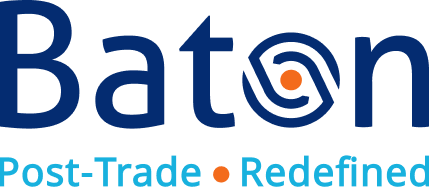How we used DLT to build a platform able to interoperate with the core ledgers, payment systems, and post-trade systems of the banks & execute distributed workflows, & exchange assets with legal settlement finality
This blog forms the second part of our distributed ledger technology (DLT) mini-series. It looks at the architecture of Baton CORE™ and specifically at why it was architected on distributed ledger technology.
Before I founded Baton Systems, I spent about 18 months meeting with around 30 different banks to learn about the problems of the post-trade world – specifically in the clearing and settlement of large value assets. The issues were always the same: the movement of assets was slow and expensive, and involved a lot of risk – with operational delays and inefficient operational processes the norm across banks.
I carefully examined both public and private/permissioned blockchains and found some interesting constructs in each, but neither of them solved the core problems. The major roadblock we faced was that a bank’s middle and back-office systems are complex, with sets of business processes and, more importantly, of technology components, all playing an important role. Not all of this could be disintermediated and in many cases it would be undesirable to do so.
Interoperability is key
“If you want to make improvements in the post-trade world, you need to interoperate with existing business processes and systems, as well as with existing legal frameworks within banks.”
So we soon realised that if we were to really address these problems, with a workable solution, we needed to build out a distributed ledger technology from scratch.
For this to work, we knew that our technology would need to interoperate with a number of internal systems within each bank. For example, the system used to manage entitlements is complex when you’re looking at multiple legal entities within a bank, and even more complex when you’re looking across banks, because one bank’s set of entitlements will not work for another. So for interoperability you need something that’s able to fit and interact with a bank’s complex systems, business processes and security models.
The other area where interoperability is important is within a bank’s core payment systems. Every payment request for example that originates or terminates in a bank is required to go through compliance checks such as AML and OFAC before it hits the streets. If you bypass these, then essentially the chain is doing something that doesn’t fit in with the legal frameworks that banks need to comply with.
Seamless integration and venue connectivity
To address this, Baton built what I like to think of as core gateway patterns. In Software, we refer to these as enterprise integration design patterns. Through these well architected, secure and tested modules, we were able to integrate seamlessly with a bank’s existing systems, be they security systems, payment gateways or post-trade systems.
Our next task was to build infrastructures and connectivity into the core settlement venues, such as exchanges, custody banks and nostro accounts. So, brick by brick, we built native connectivity into the largest exchanges globally.
We built the same native connectivity to custody banks and to nostros and SWIFT gateways. What we essentially achieved was out-of-the-box connectivity to these core venues. We also provided gateways to integrate with the existing infrastructures of the banks. So we now have connectivity into the banks and connectivity into the settlement venues.
Middleware: where distributed ledger technology comes into its own
“We wanted to make sure we brought in the three core constructs of distributed ledger technology: transparency, workflow and auditability.”
The most important thing was to bring in constructs of real-time and collaboration between parties interacting on the ledger.
People have become used to trading in real-time, in nanoseconds, while the post-trade processes take two days, or sometimes even longer. With our use of DLT we were able to provide the ability for users to view the lifecycle of a trade, to watch the exposures and obligations build in real-time and to start collaborating with their counterparty on the Baton platform. “This is an industry game changer.”
There were blockchains also working to solve these issues, but to our knowledge, these projects hadn’t previously been able to move beyond a proof of concept. This may have been because they did not provide for the key constructs of the gateways that needed to integrate with the core systems of a bank. By connecting into these core systems, and into the venues – that is, the exchanges, the custody banks and the nostro accounts – we made collaboration possible. “By using distributed ledger technology we have made smart contracts really smart, and provided the ability to execute them across institutions, allowing for real time visibility and collaboration.”
Customisable distributed workflows
Of course, every bank is different, so how do you customise the workflow of an individual bank whilst still allowing interoperability with others? We found the answer by using the constructs of public and private steps, which I will cover in a future blog post – our technology allows a bank to customise a smart contract and fit in with existing business processes whilst still being able to collaborate actively with a counterparty. By enabling this we have been able to bring significant benefits to the market.
As a result, through our use of distributed ledger technology we were able to build a platform with the ability to interoperate with the core ledgers, payment systems, and post-trade systems of the banks and execute distributed workflows, and exchange assets with legal settlement finality.
Baton’s technology improves market efficiency
Earlier I mentioned the problems of high costs, delays and lack of auditability. With our use of distributed ledger technology we have been able to significantly cut costs and delays for our clients.
This achieves real efficiencies for market participants.
For auditability, we have benefited from the core constructs of the blockchain – that is, tamper resistance and non-repudiation. We are very enthused about the possibilities that this opens up.
“We are excited about what we have built and I think the markets are too. We are very humbled by the efficiencies we are able to bring to our early adopters.”
I hope that I have explained the unique benefits of Baton CORE’s distributed technology architecture. Please reach out if you have any questions or would like further information by emailing [email protected].

